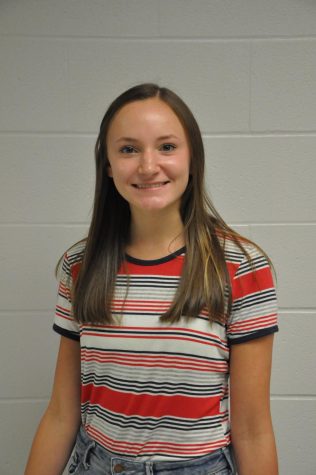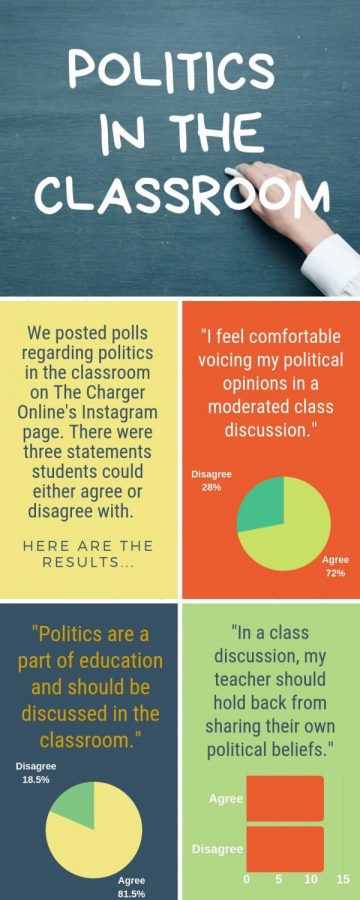Saving a Seat for Politics in the Classroom
Government. Econ. US History. AP Lang. Speech and Debate.
With the hundreds of classes offered at Carroll, politics can’t help but come up in conversation from time to time. Whether it’s the debate on stricter gun laws, the controversy on abortion, or the acceptance of the president himself, every student and every teacher has an opinion.
But is there room for politics in the classroom?
“The Lost Art of Disagreeing”
We’ve all seen it. On Twitter, on the news, before our very own eyes: people so blinded by their own opinions, they run away from anyone else’s as if hearing a differing side invalidates their own.
But that’s not how it has to be. That’s not what this new generation of voters and doers and dreamers have to be taught.
Instead, the next generation of voters can be taught hearing someone else’s opinion doesn’t mean agreeing with it. They can be taught every story has two sides. They can be taught people are more than an opinion they can’t accept.
The next generation can be taught this in schools through healthy, class discussions.
“One of the things, in this world we live in now, seems like the lost art of disagreeing through a good, healthy conversation,” said Principal Mr. Bitting. “I think that if we [teachers] have the ability to show how that’s done properly, to show how a good conversation between two people that have opposing views can occur in a healthy way, I think that can have tremendous impact on generations moving forward on trying to get the discourse back to where its a healthy discourse.”
In Mr. Hensinger’s US History classes, discussing topics such as slavery and the women’s rights movement means politics are never far behind, but instead of redirecting the discussion away from current issues of debate, he sees it as an opportunity for students to better understand each other.
“The beautiful thing about it is that in a debate-type setting, it allows them [students] to hear other points of view and counter-arguments and to think so that they’re not in their own little bubble,” said Mr. Hensinger. “I really don’t try and avoid it, what I really do try and do, though, is I try to moderate it a little bit so that everyone is respectful and conscious and courteous of the fact that everyone can have a different opinion and that’s okay.”
Creating a Culture
Everyone has an opinion, but not everyone is comfortable sharing.
According to a poll from the Charger Online’s Instagram page, 28 percent of students feel uncomfortable voicing their political opinions in a moderated, class discussion. Whether it be because of that kid in the back of the class who turns everything into an argument, an opinion that seems “too far out there,” or fear of what others might think, speaking up sometimes doesn’t feel worth it.
In Mrs. Wisehart’s AP Lang class, students analyze a piece of persuasion, apply what they know about what’s happening in politics, government, or history, and choose a respective side. Because of the climate of debate in her room, she dedicates the first week or two of school on creating an environment that welcomes and celebrates each person’s voice in efforts to break down this barrier held by 28 percent of students.
“The last five days, all I’ve been doing is establishing a culture in my classroom where students can feel free to express their beliefs, even if they’re super controversial,” Mrs. Wisehart said. “I’ve spent the last five days establishing a culture where I have no tolerance for people who, in debate, treat you badly and call you names. We will all hear each other and we’ll listen and consider.”
A Teacher’s Role
In United States History, the class conversation bounces from the natural rights of life, liberty, and the pursuit of happiness to the constitutionality of abortion. A lesson about the second amendment detours into a debate on stricter gun laws. A reflection on the harsh reality that was slavery morphs into the topic of racial discrimination seen in society today.
Politics can seep into even the most unexpected lessons, and with over 80 percent of students agreeing politics have a place in the classroom, it leaves the discussion up to the teacher on how to manage.
“I try and facilitate it. Personally, I like to play the devil’s advocate to get them thinking…and give a counterpoint,” said Mr. Hensinger. “Then someone will be like ‘yeah’ and they’ll throw out their opinion and they’ll be on track with what I said. Then I’ll flip right around and go the other way.”
The name of the game as a teacher is counterpoints. They want students on all sides of the debate to voice their opinions to get other students thinking beyond their own beliefs.
“As far as calling other students into it, if I’ve determined, hey this kid might feel this way on a topic based on previous comments, then maybe I’ll try and get their opinion to get different views and counterpoints,” said Mr. Hensinger.
The Policy on a Partisan Teacher
Teachers can play “the devil’s advocate,” they can give counterpoints and show the opposite perspectives, but at the end of the day, they are people, too. People with opinions of their own.
In Tinker v. Des Moines, the Supreme Court decided students do not “shed their constitutional rights to freedom of speech or expression at the schoolhouse gate.” As long as their speech or expression is not disruptive to the school day, they are still protected under the first amendment.
But the same cannot be said for teachers.
According to the American Civil Liberty Union, what teachers “say or communicate inside the classroom is considered speech on behalf of the school district and therefore is not entitled to First Amendment protection.”
Different school districts have different policies, but under NACS’s Staff Bylaws and Policies, it is in a teacher’s staff ethics to “refrain from using their position or public property, or permitting another person to use an employee’s position or public property for partisan political or sectarian religious purposes.”
With that being said, teachers do still have a voice, a voice that can be used outside of the classroom setting.
NACS’s school board “acknowledges the right of its certified staff members, as citizens in a democratic society, to speak out on issues of public concern” in non-instructional settings. Teachers are expected to make clear, however, that their opinions are opinions of their own and not that of the entire district.
When it comes to topics that pertain to schools such as government funding for public education, arming teachers, and stricter gun laws, teachers inevitably have opinions.
They’re the ones who deserve more compensation for all they do.
They’re the ones practicing the ALICE drills with students.
They’re the ones who would be armed with guns.
But while their opinions may be firm and their first-hand experience in a classroom stronger than any politician’s, they are still expected to withhold their personal beliefs while teaching.
“I believe that if they [teachers] want to go to the statehouse and talk to lawmakers about a certain thing with their knowledge of the school, I think that they have every right to do that,” said Mr. Bitting. “But when you’re in that classroom with those students, our true job…is to increase their ability to think and do…We do that by hopefully challenging them to think. We can do that without influencing them on how we believe.”
A Teacher’s Perspective
Under NACS’s policy, teachers aren’t to use their platform to share political opinions, but still, some do. Regardless of whether it’s allowed or not, it does happen, sometimes unintentionally and sometimes with full intent, leaving both students and teachers split on the debate of whether or not teachers should share their political opinions in instructional settings.
According to the Charger Online’s Instagram poll, the debate is split down the middle, with half students agreeing and half students disagreeing teachers should withhold their personal political opinions in the classroom.
But despite the beliefs of students, most teachers are on the same page–their political opinions, however strong, do not have a place in the classroom.
“Yes, I have really strong political beliefs,” said Mrs. Wisehart. “But here’s my deal: I am not afraid to talk about those beliefs one on one, but I feel like my job in the classroom is to allow for every single person to be heard and I feel that they should never feel intimidated to speak about what they believe out of fear of what I might think.”
Students, especially high school teens, are at a stage in life where they feel as if they are being watched, judged, and weighed by every one of their peers. Teachers, therefore, are a safe place, a place without room for judgment.
“As good of a person we are, everyone has a bias,” said Mr. Bitting. “Everyone is biased towards someone, something. I wouldn’t want to put that into somebody…Students have the ability to ponder this stuff [politics] and grow and mature as they go. I wouldn’t want to tarnish that.”
With the cons aside, there are some benefits of a teacher sharing their opinions, especially when that opinion is something widely accepted.
“I’ve had students in the past, not from Carroll, who were relatively okay with the idea of slavery and racism and I made it clear that this is not okay,” said Mr. Hensinger. “I try and pull back and just be the facilitator and moderator regardless of how I feel unless its a definite topic that needs to be addressed. Even with that, students and teachers still have their own opinions, so I’ve found that it really doesn’t matter if I do that sometimes…but hopefully, they get something to think about and more to chew on mentally.”
It’s a teacher’s personal choice. There are teachers here who vocalize their opinions daily and there are others who won’t give even the slightest of hints on where they stand. It all comes back to what kind of environment the teacher wants to create in their classroom because, like any other political belief, there are pros and cons to each side of the debate.
“I don’t think its right or wrong. It’s just the way I feel I want to create the culture in my classroom. Everyone creates those cultures differently–it’s a personal choice,” said Mrs. Wisehart who chooses to withhold her beliefs while teaching. “I think there’s a lot of advantage to some people who are showing that passion because what they’re doing is they’re modeling to students that you can have a passion for something.”
Save a Seat for Politics
Regardless of whether or not teachers should express their own beliefs, a healthy, class debate on current societal issues has as much of a place in the classroom as solving for x in algebra or reading Shakespeare in English. Teaching the whole child means not only educating them on the real-world issues of today, but also on how to effectively and appropriately discuss such topics of debate through healthy conversation.
“The goal is for those students to leave that classroom going ‘I never thought about it like that.’ ‘That’s a really unique perspective,’” said Mr. Bitting. “That’s what we hope they leave the classroom with.”

Remmington is a senior at Carroll. This is her third year on the newspaper staff and second year as co-editor in chief. She is an avid writer...


